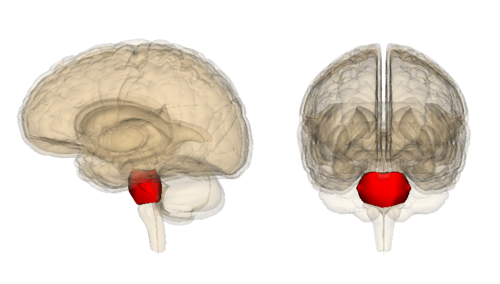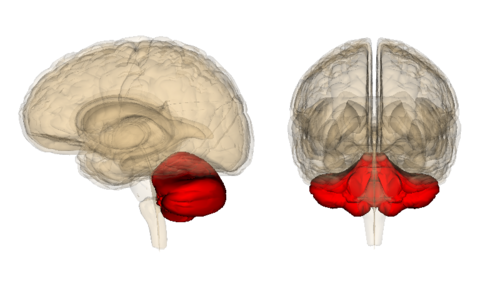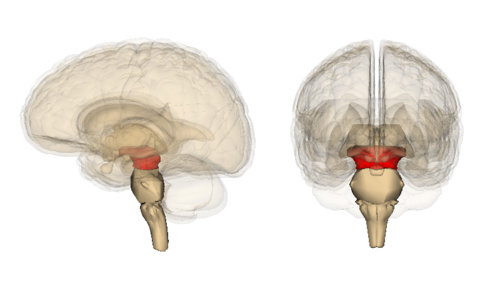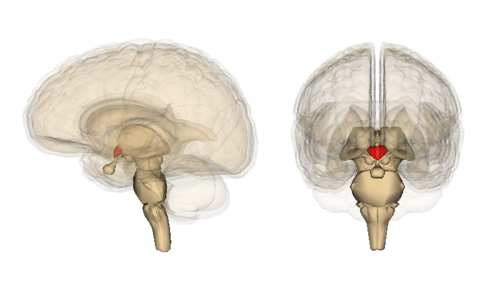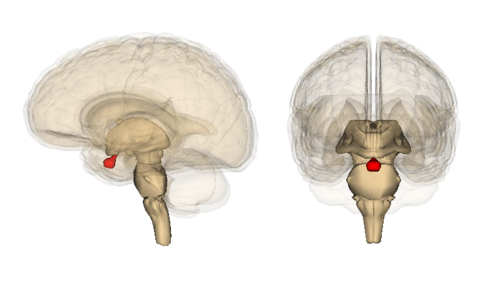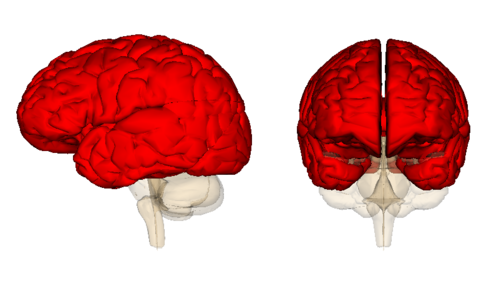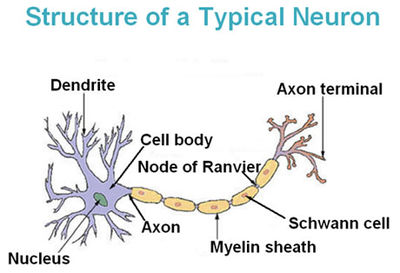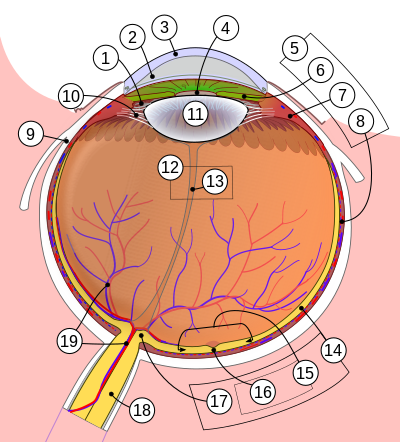AY Honors/Brain and Behavior/Answer Key
1. Be able to label a diagram or a model of a human brain including the following parts and tell briefly what each part does:
2. What is a neuron? Draw a picture of a typical neuron and label its parts. Where does information enter a neuron and where does information leave from?
Neurons (also called nerve cells) are a major class of cells in the nervous system. In vertebrates, they are found in the brain, the spinal cord and elsewhere in the nervous system. Their primary role is to process and transmit neural information. One important characteristic of neurons is that they can generate and propagate electrical signals.
Neurons are discrete cells which communicate with each other via specialized junctions. Information enters the neuron primarily through the dendrites and exits through the axon.
Neurons communicate with one another and to other cells through synapses, where the axon terminal of one cell connects to a dendrite of another.
3. Explain how drugs affect the function of neurons especially at the 'synapse'. Make a commitment never to take drugs except for medical reasons.
Axons carry electrical signals from a neuron to the dendrite of another neuron. However, an axon cannot transmit these electrical signals directly to a dendrite - it needs a synapse to do this. The synapse converts the electrical impulse to a chemical reaction, which releases different types of chemicals called neurotransmitters. These neurotransmitters travel across the synapse and cause other chemical reactions which generate electricity in the dendrite.
The synapses can be "trained" to react strongly, weakly, anywhere in between, or not at all. It is because they can adapt that we are able to learn new things, form habits (good or bad), or suffer from addictions.
Many drugs affect the way the synapse does its job by preventing the neurotransmitter chemicals from traveling across the synapse. Drugs can also amplify these reactions, so that they are more intense than they would have been in the absence of the drug.
4. What is a reflex? Perform a knee-jerk reflex test on someone. Explain why it occurs (use the following terms in your answer: sensory neuron, motor neuron, spinal cord). Why do doctors use this test in a physical exam?
Instructions: Gently tap someone just below the knee-cap while the person's leg is hanging over the edge of a chair.
A simple reflex is entirely automatic and involves no learning. An example is the escape reflex (e.g., the sudden withdrawal of a hand in response to a pain stimulus), or the patellar reflex (the jerking of a leg when the kneecap is tapped). Sensory neurons in the stimulated body part sends a signal to the spinal cord. Within the spinal cord a reflex arc switches the signal straight back to the muscles of the body (in this case the arm or the leg) to a motor neuron; contraction of the muscle occurs (the arm or leg jerks upwards). Only three nerve cells are involved, and the brain is only aware of the response after it has taken place.
The deep tendon reflexes provide information on how well of the central and peripheral nervous systems are working. Generally, decreased reflexes indicate a problem in the peripheral nervous system. Lively or exaggerated reflexes indicate a problem in the central nervous system.
5. What is a sensory neuron, and what is "adaptation".
Sensory neurons are nerve cells within the nervous system responsible for converting external stimuli from the organism's environment into internal electrical impulses. For example, some sensory neurons respond to tactile stimuli and can activate motor neurons in order to achieve muscle contraction. Such connections between sensory and motor neurons underlie motor reflex loops and several forms of involuntary behavior, including pain avoidance. In humans, such reflex circuits are commonly located in the spinal cord.
Neural adaptation is a change over time in the responsiveness of the sensory system to a constant stimulus. It is usually experienced as a change in the stimulus. For example, if you rest your hand on a table, you immediately feel the table's surface on your skin. Within a few seconds, however, you cease to feel the table's surface. The sensory neurons stimulated by the table's surface respond immediately, but then respond less and less until they may not respond at all; this is neural adaptation.
Demonstrate adaption by doing the following: Rest your arm on a table and then place a small cork (or something very light) on your arm.
Notice how it feels at that time and how it feels one minute later after not moving.
Place one finger of one hand in a bowl of cool water and another finger of the other hand into a bowl of warm water.
After 30 seconds, put both fingers in to a bowl of water at room temperature. How does the water at room temperature feel on each finger?
What spiritual lesson can be drawn from the concept of adaption?
Just as the sensory system can adapt to a stimulus until it no longer even notices it, we can adapt to a sinful environment until we no longer notice the sin. The conscience becomes numbed when ignored. We must be careful about the sorts of stimuli we allow ourselves to be subject to. Watching television programs that promote sin will dull our senses to the enormous evil of sin just as a constant stimulus to the skin will dull our perception to it.
6. How are the senses of taste and smell similar and how are they different.
Draw a map of which part of the tongue responds to the following tastes: sweet, sour, bitter, salt. Instructions: Have someone dip a Q-tip into one of the following: sugar water (for sweet), lemon juice (for sour), flat tonic water (bitter) or salty water (salt), and then lightly touch different parts of your tongue. Notice which areas of the tongue taste the solution that is being tested. Rinse with pure water between each test and use a new Q-tip for each test.
Both the sense of taste and the sense of smell detect the chemical composition of a substance through chemoreceptors. Taste is detected by the tongue in solids and in liquids, while smell is detected by the nose in airborn substances.
There is much debate in the scientific community as to whether the "taste map" is a real phenomenon or not. Those who espouse the theory say that sweetness is best detected at the tip of the tongue, bitterness at the back of the tongue, saltiness at the sides of the tongue, and sourness further back along the sides of the tongue. Those who dismiss the theory say that each of these tastes can be detected on all regions of the tongue, and that the "taste map" is based on a misinterpretation of a German medical paper by a Harvard psychology student in 1901. Try the experiment yourself as outlined in the requirement and draw your own conclusions.
7. Draw a picture of the various parts of the eye and explain why you have a blind-spot. Find your blind-spot for one eye.
Instructions: Place a very small black dot on the center of a white piece of paper. Close one eye and stare directly ahead. Hold the paper at arms length in front of you and move the paper until the spot "disappears" (usually this is occurs when the dot is just a bit below eye level - it is important).
The retina is a thin layer of cells at the back of the eyeball; it is the part of the eye which converts light into nervous signals.
The retina contains photoreceptor cells (rods and cones) which receive the light; the resulting neural signals then undergo complex processing by other neurons of the retina, and are further processed in the retinal ganglion cells whose axons form the optic nerve. The retina not only detects light, it also plays a significant part in visual perception.
The optic disc is a point on the retina where the optic nerve pierces it to connect to the nerve cells inside the retina. No photosensitive cells exist at this point, and it is therefore "blind".
8. Describe the three basic parts of the ear and tell what each part does. Explain why the following activities can be bad for your hearing: listening to a "walkman", putting something long in your ear, being in the front row at a loud music concert, not treating an ear infection properly, standing behind a jet at an airport
The three basic parts of the ear are the outer ear, middle ear, and inner ear.
- The outer ear is the external portion of the ear and includes the eardrum. The pinna, which is the external portion of the ear, captures the sound and transfers them through the auditory canal to the eardrum, which vibrates and transfers the sound to the tiny bones in the middle ear.
- The middle ear includes the ossicles (three tiny bones), two muscle tendons, and two nerve bundles. The Eustachian tube connects from the chamber of the middle ear to the back of the pharynx to equalize the pressure. That's why you can feel your ears "pop" when descending on an airplane.
- The inner ear comprises both the organ of hearing (the cochlea) and the labyrinth or vestibular apparatus, the organ of balance located in the inner ear that consists of three semicircular canals and the vestibule. Within the cochlea are located three canals: the tympanic canal, the vestibular canal, and the middle canal. When sound strikes the cochlea, the fluid inside is moved. This fluid stimulates the organ of Corti, located within the middle canal, to interpret the sound and send the information through the auditory nerve to the brain.
Causes of Hearing Loss
Listening to a "walkman"
Personal electronic audio devices, such as Walkmans and iPods (iPods often reaching 115 decibels or higher), can produce powerful enough sound to cause significant Noise-Induced Hearing Loss, even though lesser intensities of even 70 decibels can also cause hearing loss.
Putting something long in your ear
Putting something long into your ear can easily puncture the eardrum. True is the saying that you should never put anything smaller than your elbow into your ear!
Being in the front row at a loud music concert
As in the case of the "walkman" question, exposure to loud sounds can damage your hearing. Live music concerts are an even greater threat to the hearing because they are so much louder than a personal electronic device, even when the listener is not close to the speakers.
Not treating an ear infection properly
An ear infection causes tissues inside the ear to swell, and this can close the tubes inside. When the tubes are blocked, pressure in the ear does not equalize, and that makes it more difficult for the eardrum to vibrate. This causes a reduction in hearing. In severe cases, the pressure imbalance can cause the eardrum to tear.
Standing behind a jet at an airport
As in the case of the loud concert, very loud noises - even brief ones - can cause severe damage to the ear, including tearing the eardrum and damaging the hair cells in the inner ear.
9. Do one or more of the following activities: (some of these activities will need to be planned with a medical/dental professional or at a local college or university— they are usually very willing to assist you)
Observe an electroencephalogram or one being performed on someone and describe what can be learned from this test.
This is the output recorded by the first electroencephalogram (EEG) administered by Hans Berger in 1929. Electroencephalography is the measurement of the electrical activity of the brain by recording from electrodes placed on the scalp or, in special cases, on the cortex. The resulting traces are known as an electroencephalogram (EEG) and represent so-called brainwaves. This device is used to assess brain damage, epilepsy and other problems. In some jurisdictions it is used to assess brain death.
Watch a "lie-detector" test being performed. Briefly explain how one works.
A polygraph or lie detector is a device which measures and records several physiological variables such as blood pressure, heart rate, respiration and skin conductivity while a series of questions is being asked, in an attempt to detect lies.
A typical polygraph starts with a pre-test interview designed to establish a connection (or find a control) between the tester and the testee and to gain some preliminary information which will later be used for "Control Questions " or C (see below). Then the tester will explain the polygraph, emphasizing that it can detect lies and that it is important to answer truthfully. Then a "stim test" is often conducted: the testee is asked to deliberately lie and then the tester reports that he was able to detect this lie. Then the actual test starts. Some of the questions asked are "Irrelevant " or IR("Are you 35 years old?"), others are "probable-lie" Control Questions that most people will lie about ("Have you ever stolen money?") and the remainder are the "Relevant Questions " or R the polygrapher is really interested in. The different types of questions alternate. The test is passed if the physiological responses during the probable-lie control questions are larger than those during the relevant questions. If this is not the case, the tester attempts to elicit admissions during a post-test interview ("Your situation will only get worse if we don't clear this up"). These admissions are the main goal of the test.
The accuracy of polygraph tests is a matter of considerable controversy. While some claim the test to be accurate in 70% - 90% of the cases, critics charge that rather than a "test", the method amounts to an inherently unstandardizable interrogation technique whose accuracy cannot be established. Critics also argue that even given high estimates of the polygraph's accuracy a significant number of subjects (e.g. %10 given a %90 accuracy) will appear to be lying, and would unfairly suffer the consequences of "failing" the polygraph. It is interesting to note that, so far, not one scientific study has been published that proves the validity of the polygraph test. Polygraph tests have also been criticized for failing to trap known spies such as Aldrich Ames, who passed two polygraph tests while spying for the Russian government.
Observe an MRI or one being performed and explain what information can be learned from such a test.
Observe a neuron under a microscope.
Observe someone receiving a local or general anesthetic and explain how an anesthetic works.
Perhaps the easiest place to do this is at a dentist's office. If you have ever had a cavity filled, the dentist very likely administered a local anesthetic.
Observe a real human brain (fresh or preserved)
Now this sounds like FUN!
10. List at least 5 things that you can do to protect your brain from damage.
- Wear a helmet. Many work and recreational activities can subject a person to head injury. It is best to not take chances - wear a helmet when it's called for! Do not enter a hard-hat area without a hardhat. Put on your helmet every time you ride your bike, go rock climbing, play football, or paddle a kayak. Why risk it?
- Exercise your brain. The more you use your brain, the better it works. The saying "practice makes perfect" is very true. Any activity that involves the brain can be improved with practice.
- Get plenty of fresh air. Your brain needs oxygen.
- Say "No" to drugs. Most of the illegal "street drugs" are popular because they affect the way people feel. The only way they can do this is by affecting the brain, and these effects are never harmless. Drugs can do permanent damage to the brain.
- Eat healthy food. Junk foods cloud the brain. Healthy foods are just as good for the brain as they are for the body.
- Live by Christian principles. Viewing inappropriate television programs, listening to music that promotes sin, and indulging in indecent reading material has a permanent effect on the brain. Memorized song lyrics stick with a person for a long time, even when that person no longer wishes to remember them.
11. Do one of the following:
Visit and help care for someone (minimum of 2 hrs) who has a disease of the brain and report on their special needs.
Briefly describe the following disorders of the nervous system:
Alzheimer's Disease
Alzheimer's disease is a degenerative disease of the brain. It is the most common cause of dementia and is characterized by progressive intellectual deterioration together with declining activities of daily living and behavioral changes. The most striking early symptom is memory loss (amnesia), usually in the form of minor forgetfulness that becomes steadily worse as the illness progresses, with relative preservation of older memories. As the disorder progresses, intellectual impairment extends to language, coordinated movement, recognition and functions such as decision-making and planning.
Multiple Sclerosis
Multiple sclerosis (MS) is a chronic disease that affects the brain and spinal cord. MS can cause a variety of symptoms, including changes in sensation, visual problems, muscle weakness, depression, and difficulties with coordination and speech. Although many patients lead full and rewarding lives, MS can cause impaired mobility and disability in the more severe cases.
Multiple sclerosis affects neurons, the cells of the brain and spinal cord that carry information, create thought and perception and allow the brain to control the body.
Epilepsy
Epilepsy is a chronic neurological condition characterized by recurrent unprovoked seizures. It has been described as electrical storms in the brain's circuitry.
All the causes of epilepsy are not known, but many predisposing factors have been identified, including brain damage resulting from malformations during brain development, head trauma, neurosurgical operations, other penetrating wounds of the brain, brain tumor, high fever, bacterial or viral encephalitis, stroke, intoxication, or acute or inborn disturbances of metabolism.
Major Depression
Major depression is a state of sadness or melancholia that has advanced to the point of being disruptive to an individual's social functioning and/or activities of daily living. It is caused by chemical imbalances in the brain.
Down Syndrome
Down syndrome encompasses a number of chromosomal abnormalities causing highly variable degrees of learning difficulties as well as physical disabilities. While most children with Down syndrome have a lower than average cognitive function, some have earned college degrees, and nearly all will learn to read, write and do simple mathematics.
Huntington's Disease
Huntington's disease (HD) is an inherited disorder characterized by abnormal body movements called chorea, and a reduction of various mental abilities. Symptoms of the disorder include loss of cognitive ability (thinking, speaking), changes in personality, jerking movements of the face and body in general and unsteady walking. These symptoms develop into dementia and cognitive decline, and an advanced form of rapid jerking.
Quadriplegic
Quadriplegia is a symptom in which a human experiences partial or complete paralysis from the neck down. It is caused by damage to the brain or to the spinal cord at a high level. The injury causes the victim to lose total or partial use of the arms and legs.
Paraplegic
Paraplegia is a condition in which the lower part of a patient's body is paralyzed and cannot move. It is usually the result of spinal cord injury or a congenital condition such as spina bifida.
12. Find at least three references from the Bible that refer to your brain and/or to decisions that you make in life.
An excellent place to find Biblical references on making decisions is Week 23 of the weekly AY reading assignments (required for Companions and Voyagers):
- Luke 14
- Matthew 4
- Mark 8
- Matthew 16
- 2 Corinthians 7:1
- 1 Peter 1:13-16
- 1 Thessalonians 4:3-8

